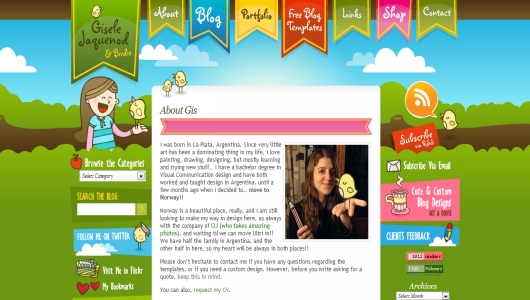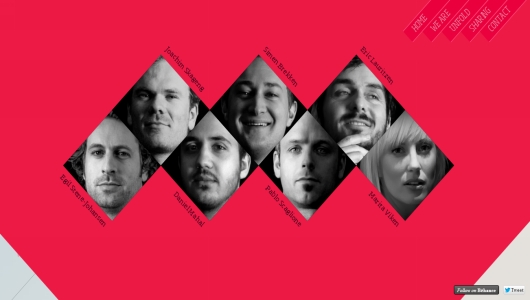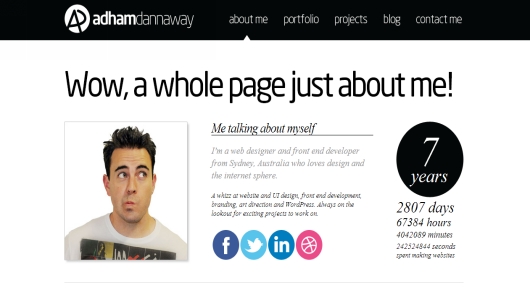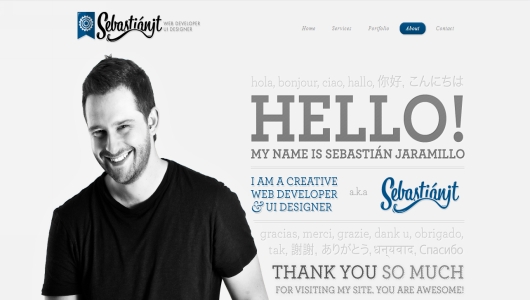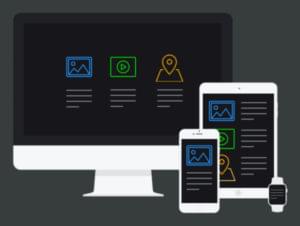5 Ways to Truly Personalize Your “About Me” Page
Whether you work for a large corporation or a small business, having an “About Me” on your website that’s actually interesting and personal is a great way to stand apart from millions of businesses and personal profiles with bland, uninspired “About Me” pages. Many of these profiles seem to exist purely because supervisors, corporate policies, or personal consciences demanded an “About Me” page, and the victim of this mandate reluctantly put together an underwhelming profile designed blend in with the crowd. This is not the right approach for a designer; if you’re going to have an “About Me” page, it better be unique, distinct, and bold. Coming up with a good page dedicated to yourself can be hard, but it doesn’t mean you can’t put together a great design.
So, what makes an effective and appealing “About Me” page? Well, in truth this depends on who you are and why you have a website, but there are a few universal best practices that can help you design a properly-prominent “About Me” page regardless of industry, skills, or personality.
Do Something Creative
When trying to stand apart from the crowd, originality is the best way to do so. Beating the same old drum in the design world makes people bored and consequently it makes them overlook you unless you have an extremely alluring specialty. Why not include that specialty as part of your profile? Creative layouts can say a lot about you and your work; it can prove that you’re innovative, willing to take risks, fun, and thoughtful. All of these tend to be great qualities to have, especially when you have an occupation in an artistic field. Using different shapes and a combination of colors can make elements of your page — as well as the page in its entirety — stand out.
Speaking of color, contrast and complimentary colors are always your friends when it comes to designing. Bold colors are great to use, but if you’re not a fan of them, try using them as minimal accent colors to draw attention to certain things. Large photo backgrounds are still a popular style in design, so taking advantage of your own stellar photography is a great idea (plus, it keeps you from sticking with a mundane solid backdrop). Make sure to pay attention to the typography you are choosing as well, and avoid linguistic cliches. Even minor changes like changing “About Me” to “Meet Me” makes for a more creative approach.
Show Yourself
Some of us just don’t like to show our face online for one reason or another, but when you’re website is geared towards working with other people, showing yourself is a good idea. First, it fosters some form of trust, and if you’re asking people to pay you for subjective design work, then you want to make yourself appear trustworthy. Second, people generally like to know who they’re reading about and dealing with.
If you are using a photo of yourself, make sure that the photo is of good quality. Taking a photo of yourself with ample light makes it easier for people to see what you look like. You should generally avoid using any creative filters on your photo, as it can cheapen the overall quality of your site.
You can also take a different route with your photo and use a large one as your background. If you are someone who strongly prefers to not use a photo of yourself, you could design an avatar in your likeness, which is a great way to further demonstrate your creativity.
Offer A Real Explanation
There is no point in having an “About Me” page if you’re not even going to talk about yourself; it just defeats the purpose. Don’t leave your visitors in the dark about who you are, but don’t overload them with every single detail of your life either. This is your “About Me” page, not your memoir, so don’t feel the need to write more than two paragraphs. Having anything over two paragraphs is pushing a visitor’s limited attention span, but it may be necessary if you have a long, relevant career history. But, first and foremost, you will want to offer a short bio about who you are and what you do.
You could also consider making yourself more personable and approachable with a few personal details (location, education, family status, pets, hobbies, etc.) if appropriate. Depending on what you site will be used for; sharing your goals could also be included. Writing about yourself can prove challenging, so writing a list can help you narrow down your options.
Be Truly Personable
I have already mentioned before that being personable is extremely important for several reasons, especially when it comes to your page. There numerous ways to foster friendliness in person, but since you’ll be working on achieving this through the web then, this all boils down to the writing. You must get as far away from “mechanical” as possible and humanize yourself as much as you can through a digital medium.
Sharing personal information is a reliable way to make yourself personable to your audience. Everyone has at least one hobby they like doing outside of work; share it if you can stand it. Additionally, pay attention to the tone of your writing, you don’t want it to come of as uptight or stuffy. Try to communicate with a friendly voice. When you’re writing your bio, you can either write about yourself in third or first-person. Some will argue that you should never write about yourself in third-person because it creates more social distance, but I have read several bios that were written in third-person and remained engaging, humorous, and personable.
Add Social Icons
Placing some social media icons linked to your most-frequented social networks is always a great idea when working on your “About Me” page. In the world of perpetually growing and advancing personal technology, offering a way or multiple ways for people to get in touch with you is ideal. It also reiterates the idea that you’re not just writing this “About Me” page because you have to; you truly are interested in interacting with your website visitors and customers.
You generally have two options in terms of offering offsite links to social networks. You can simply hyperlink text, or you can go with those ubiquitous social media icons. Social media icons are offered all over the web, coming in different shapes, sizes, colors, and designs that give you tons of options. But, the wide availability of social icons also makes them an extremely common presence on “About Me” pages, so you might want to get a little more creative about how you send users to your social profiles.
Conclusion
Keep your purpose in mind when crafting your “About Me” page. If you’re truly just trying to blend in, but you feel obligated to publish an “About Me” page, then it’s easy enough to put together an ordinary, boilerplate design. But, most design professionals want to complete and stand out, and a designer’s personal page is a perfect opportunity to show off your ingenuity and skills, especially if you have some tricks up your sleeves that you haven’t been able to showcase in your portfolio or client work. For once, this design really is your page, don’t be afraid to express yourself!
Frequently Asked Questions (FAQs) About Personalizing Your “About Me” Page
What are some creative ways to personalize my “About Me” page?
Personalizing your “About Me” page can be done in several ways. You can start by telling your story in a unique and engaging way. Instead of just listing down facts about yourself, weave them into a narrative that reflects your personality. You can also use visuals like photos or infographics to make your page more appealing. Including testimonials or quotes from others about you can also add a personal touch. Lastly, don’t forget to show your personality through your writing style. Be authentic and let your true self shine through.
How can I make my “About Me” page stand out?
To make your “About Me” page stand out, focus on what makes you unique. Highlight your skills, experiences, and passions that set you apart from others. Use a unique design or layout for your page. Include high-quality images or videos that showcase your personality or work. Also, consider adding interactive elements like a slideshow or a video to engage your visitors.
What should I avoid when writing my “About Me” page?
When writing your “About Me” page, avoid being too formal or impersonal. This page is your chance to show your personality and connect with your audience on a personal level. Avoid using jargon or complex language that your audience may not understand. Also, avoid being too self-promotional. While it’s important to highlight your achievements, make sure to do so in a way that is relatable and engaging.
How often should I update my “About Me” page?
Your “About Me” page should be updated regularly, ideally every few months. This ensures that the information on your page is current and relevant. Regular updates also give you the opportunity to showcase your latest achievements or projects.
Can I include links to my social media profiles on my “About Me” page?
Yes, including links to your social media profiles on your “About Me” page is a great way to connect with your audience on a deeper level. It allows them to see more of your personality and work, and gives them a way to interact with you directly.
How can I make my “About Me” page more engaging?
To make your “About Me” page more engaging, consider adding interactive elements like videos or slideshows. You can also use storytelling techniques to make your content more engaging. Including a call-to-action at the end of your page can also encourage engagement.
What kind of information should I include on my “About Me” page?
Your “About Me” page should include information about your background, skills, experiences, and passions. You can also include testimonials or quotes from others about you, as well as links to your social media profiles or portfolio.
How long should my “About Me” page be?
There’s no set length for an “About Me” page. It should be long enough to provide a comprehensive overview of who you are and what you do, but not so long that it becomes overwhelming for your audience. Aim for a balance between detail and brevity.
Can I use humor on my “About Me” page?
Yes, using humor on your “About Me” page can be a great way to show your personality and make your page more engaging. However, make sure that your humor is appropriate for your audience and fits with your overall brand image.
Should I include a photo of myself on my “About Me” page?
Including a photo of yourself on your “About Me” page can help to personalize it and make it more engaging. However, make sure that the photo is professional and reflects your brand image.
Gabrielle is a creative type who specializes in graphic design, animation and photography.

